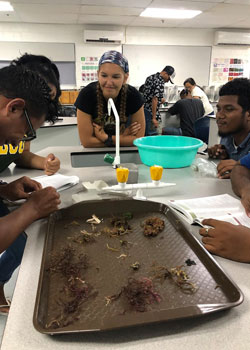
Alexa Runyan’s deep fascination with the ocean will soon explore new depths. The University of Hawaiʻi at Hilo senior has received a highly competitive Graduate Research Fellowship from the National Science Foundation (NSF). The five-year fellowship includes three years of financial support with an annual stipend of $34,000 and a $12,000 cost of education allowance.
The award comes as she closes in on earning a bachelor of science in marine science with a minor in physics and a certificate in data science at UH Hilo. Runyan has been accepted to the ocean engineering graduate program at the University of Rhode Island (URI).
“I am beyond grateful for my advisors for all of their support and trust throughout my time at UH Hilo,” Runyan said. “They truly gave me the tools and the confidence to grab every opportunity to grow as a scientist and develop my research interests. The experiences and lessons I have from UH Hilo will travel with me indefinitely as I pursue my graduate studies and a career in ocean engineering.”
The NSF fellowship recognizes and supports outstanding graduate students in NSF-supported science, technology, engineering and math (STEM) disciplines who are pursuing research-based master’s and doctoral degrees at accredited U.S. institutions.
“Alexa has an outstanding work ethic,” said John H.R. Burns, a UH Hilo marine science assistant professor. “Her intelligence and enthusiasm have helped us progress our data analysis and understanding of these valuable marine systems.”
Runyan assisted Burns in rendering and analyzing 3D coral models from sites around the French Frigate Shoals, the largest atoll in the Northwestern Hawaiian Islands. As an undergraduate student at UH Hilo, Runyan, originally from Marin County, Calif., has been conducting marine science and data science research with Burns who specializes in coral biology, coral reef ecology, 3D modeling and data visualization. Burns founded the Multiscale Environmental Graphical Analysis (MEGA) Lab at UH Hilo.
Kathy Cooksey, associate professor and chair of the physics and astronomy department at UH Hilo said Runyan is a very proactive student who clearly took advantage of what the university has to offer across disciplines to build her skillset and grow as a scientist.
Applied learning

As part of being a data analysis intern with Burns, Runyan is also an ʻIke Wai Scholar. In 2020, she was a member of a team of students and faculty in the ʻIke Wai Research Experience in Data Science Program at UH Hilo; their work on coral health and disease was published in Frontiers Marine Science on May 6. The article, “A Comparison of the Diagnostic Accuracy of in-situ and Digital Image-Based Assessments of Coral Health and Disease,” is the result of research done in summer 2019. The study addresses a pressing issue of the capability of digital images to be used for detecting disease in marine environments and provides the pros and cons of using new technologies versus conventional techniques.
Burns said Runyan played a substantial role in supporting the ʻIke Wai project through the application of data science tools. “Specifically, she [helped] us map and quantify coral reef habitats throughout the Hawaiian Archipelago,” he explained. “Her work is helping to track change in coral community structure and habitat complexity associated with environmental disturbances, and also assisting with developing machine learning algorithms to automate identification of benthic (deepest depths) organisms.”
In the summer of 2019, Runyan joined two marine scientist faculty for a trip to Majuro and Arno Atoll in the Republic of the Marshall Islands to lead an eight-week “bootcamp” for budding Marshallese marine scientists enrolled at UH Hilo. Runyan, who served as teaching assistant for the place-based learning program, worked with Steve Colbert, chair and associate professor of the UH Hilo marine science department, and Karla McDermid, professor of marine science at UH Hilo. Runyan is a divemaster and instructed the students in benthic surveying and photographing of the atoll’s coral reef system. She also assisted with activities in the lab.
For more go to UH Hilo Stories.
—Story by Susan Enright

